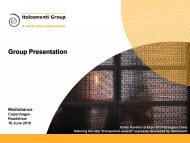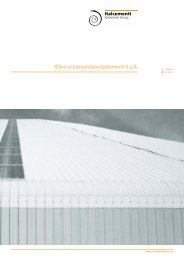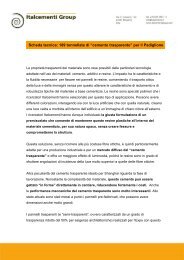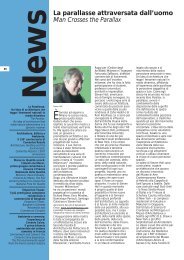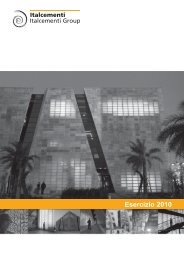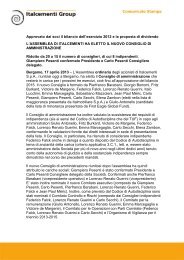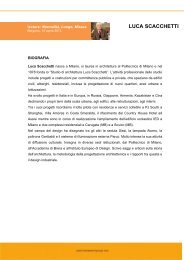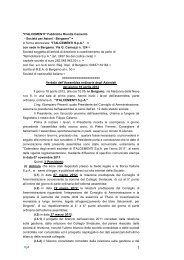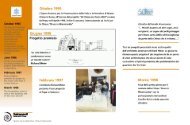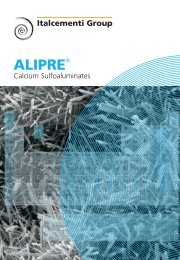88-96**news ital-ingl 2¡ bozza - Italcementi Group
88-96**news ital-ingl 2¡ bozza - Italcementi Group
88-96**news ital-ingl 2¡ bozza - Italcementi Group
You also want an ePaper? Increase the reach of your titles
YUMPU automatically turns print PDFs into web optimized ePapers that Google loves.
commitment to improving the<br />
working conditions in our<br />
companies,” points out Sabine<br />
Vèron, Ciments Calcia’s<br />
marketing manager for<br />
cement bags. “We<br />
immediately converted our<br />
plants and began production.<br />
The results of the first tests<br />
conducted with our customers<br />
are very encouraging.”<br />
Innovation across the<br />
board<br />
For some time now, Ciments<br />
Calcia plants have been<br />
preparing to renovate all their<br />
production activities by<br />
completely revamping their<br />
infrastructures. The<br />
adaptation and, in most cases,<br />
the complete renovation of<br />
the bagging lines has become<br />
necessary. The overall cost will<br />
amount to approximately €30<br />
million. It will take three years<br />
to complete the project: a<br />
relatively short timeframe<br />
considering the complexity of<br />
the operation.<br />
“We had to rethink our<br />
production lines from A-Z,”<br />
says Jean Luc Descaves of the<br />
Cement Production and<br />
Technology Department. “The<br />
packing machines must be<br />
capable of handling large<br />
numbers of 35 kg bags. The<br />
automated systems that place<br />
the bags in front of the filler<br />
ducts have been changed. The<br />
weighing system is also new.<br />
It is now capable of<br />
automatically determining the<br />
weight of each unit and<br />
sending excess product<br />
through for recycling.”<br />
Once filled and packed, the<br />
bags are sent through a<br />
cleaning device and then piled<br />
onto pallets by a new loading<br />
system. A gluing machine<br />
completes the cycle to make<br />
the lot more stable. A highspeed<br />
printer prints the<br />
production date on each bag<br />
and, upon request, the pallets<br />
can be wrapped in a<br />
thermoplastic film to protect<br />
them against the weather.<br />
Jean Luc Descaves points out<br />
that, “one of our priorities in<br />
the renovation phase was<br />
safety. The machines had to<br />
meet the highest standards,<br />
and suppliers organized<br />
special training courses for the<br />
equipment they installed.”<br />
The new lines are operational<br />
in nine out of the twelve<br />
Ciments Calcia plants.<br />
“The 35 kg bag is our future,”<br />
concludes Jean Luc Descaves.<br />
Talking packages<br />
The reorganization of the 35<br />
kg bag packing lines provided<br />
the incentive to rethink the<br />
appearance and re-define the<br />
very concept of the bag.<br />
As a result, bags have become<br />
an effective means of<br />
communication, assisting<br />
customers in their choices<br />
with clear instructions on how<br />
to use their contents.<br />
“The basic idea was to put our<br />
solutions and our customers’<br />
needs in direct contact,” says<br />
Sabine Vèron. The challenge?<br />
To create a clear and simple<br />
language to present the full<br />
breadth of our product line<br />
and all its characteristics. The<br />
basic concept is to structure<br />
the contents according to the<br />
final use of the product.<br />
The line is divided into three<br />
main categories: Calcia<br />
“Structures,” Calcia<br />
“Masonry” and Calcia<br />
“Finishings.” These<br />
commercial names clearly<br />
indicate the intended use and<br />
are supplemented with<br />
additional information about<br />
the resistance rating of the<br />
products and, in certain cases,<br />
other complementary<br />
characteristics (ES, for<br />
example, stands for “eaux<br />
sulfatées,” sulphated waters).<br />
A short descriptive sentence<br />
provides a detailed<br />
explanation of the use of the<br />
product: Ultracem, for<br />
example, is a “highperformance<br />
cement.”<br />
Hugues de Penfentenyo, Sales<br />
Manager, illustrates the<br />
foundation of the project’s<br />
communications strategy.<br />
“The term ‘cement’ is too<br />
generic, it says nothing about<br />
the use and characteristics of<br />
the product. The product<br />
names were too technical,<br />
and new European norms<br />
certainly did not simplify<br />
things. We simply chose to<br />
emphasize the ‘personality’ of<br />
each product, based on<br />
specific needs and actual<br />
market demand.”<br />
After an extensive creative<br />
process, the idea of<br />
introducing the suffix “CEM,”<br />
universally understandable in<br />
Europe, was born. Moreover,<br />
to make things as simple as<br />
possible, each bag is clearly<br />
marked with a quality seal<br />
and the plant’s environmental<br />
certification level.<br />
Ultimately, the goal of this<br />
minor linguistic revolution is<br />
to simplify the work for<br />
anybody using or selling the<br />
cement. This is further proof<br />
of <strong>Italcementi</strong> <strong>Group</strong>’s active<br />
interest in fostering clear and<br />
direct relations with its<br />
customers.<br />
1. Sfic: French Cement<br />
Manufacturers Union<br />
2. Capeb: Confederation of<br />
craftsmen and small construction<br />
companies<br />
3. FFB-UMGO: French Construction<br />
Federation - Union of builders and<br />
major construction works<br />
4. FNNMC: French federation for<br />
trading in construction materials<br />
95<br />
Angeli in cementeria<br />
Angels at the cement plant<br />
<strong>Italcementi</strong> regala un<br />
defibrillatore mobile alla<br />
comunità di Colleferro<br />
Nella cementeria <strong>Italcementi</strong><br />
di Colleferro, vicino a Roma,<br />
fa il suo ingresso un<br />
dispositivo sofisticato che non<br />
servirà a incrementare la<br />
produttività, ma avrà lo scopo,<br />
socialmente più utile, di<br />
salvare vite umane.<br />
La donazione del defibrillatore<br />
semiautomatico mobile, così si<br />
chiama l’apparecchiatura, fa<br />
parte di un progetto più vasto,<br />
ideato dall’Associazione<br />
“Angeli del cuore”.<br />
Il programma, avviato nel<br />
1999, prevede di creare una<br />
rete di postazioni su tutto il<br />
territorio nazionale, per<br />
prevenire la morte improvvisa<br />
da arresto cardiaco, una<br />
patologia che in Italia colpisce<br />
un abitante su mille.<br />
Un evento tutt’altro che raro,<br />
con conseguenze<br />
drammatiche e un tempo<br />
d’intervento ridottissimo.<br />
Solo cinque minuti, prima che<br />
il cuore e il cervello subiscano<br />
danni irreversibili.<br />
Mario Del Prete, Presidente<br />
dell’Associazione “Angeli del<br />
Cuore” e Assessore alla Sanità<br />
del Comune di Colleferro, ci<br />
parla dell’iniziativa: “L’unica,<br />
efficace prevenzione consiste<br />
nell’organizzazione di una rete<br />
“ragionata” di punti di<br />
soccorso. Ovviamente non<br />
bastano gli strumenti, è<br />
necessaria anche la presenza<br />
di personale qualificato e<br />
specificamente addestrato. È<br />
importante sottolineare che<br />
non è necessaria l’assistenza<br />
di un medico o di un<br />
infermiere. La tecnologia oggi<br />
è in grado di realizzare<br />
defibrillatori semiautomatici<br />
che riconoscono l’aritmia<br />
cardiaca e forniscono<br />
l’indicazione di erogare lo<br />
shock elettrico solo ed<br />
esclusivamente in caso di<br />
fibrillazione ventricolare o<br />
tachicardia ventricolare”.<br />
Significative in questo senso le<br />
esperienze negli Stati Uniti e<br />
in Europa. Nelle città dove<br />
l’assistenza è riservata<br />
esclusivamente al personale<br />
medico qualificato, ad<br />
esempio a New York, la<br />
percentuale di sopravvivenza è<br />
minima, dall’1 al 2%,<br />
soprattutto per la lentezza dei<br />
tempi di intervento. Al<br />
contrario, dove prevale il<br />
modello della diffusione<br />
capillare con l’assistenza di<br />
personale non medico, come<br />
a Rochester, nel Minnesota, la<br />
percentuale sale al 47%.<br />
In Italia, dove ogni anno si<br />
verificano più di quarantamila<br />
casi, se l’intervento fosse<br />
effettuato tempestivamente,<br />
entro i fatidici cinque minuti,<br />
si potrebbero salvare almeno<br />
diecimila persone. “Sono dati<br />
che fanno pensare – prosegue<br />
Mario Del Prete – e che ci<br />
hanno fornito motivazioni<br />
fortissime per dare inizio al<br />
nostro progetto. Colleferro è<br />
la seconda città, dopo<br />
Piacenza, a impegnarsi nella<br />
creazione di questa rete di<br />
punti di primo intervento.<br />
Siamo quindi un centro pilota,<br />
anche per le caratteristiche del<br />
nostro Comune, punto di<br />
riferimento industriale e<br />
commerciale delle zone<br />
circostanti con un territorio<br />
che si estende<br />
complessivamente per circa<br />
100 chilometri con una<br />
popolazione di 100.000<br />
abitanti.<br />
Naturalmente, l’impegno<br />
diretto richiesto alla comunità<br />
è notevole, perché accanto ad<br />
ogni defibrillatore ci deve<br />
essere una squadra di<br />
volontari che abbiano seguito



